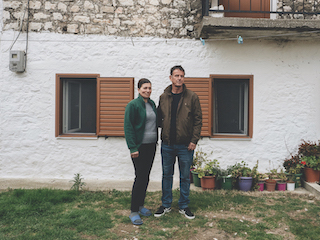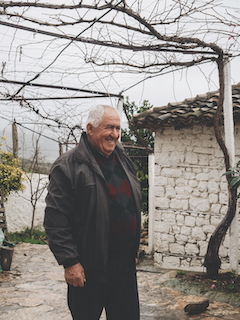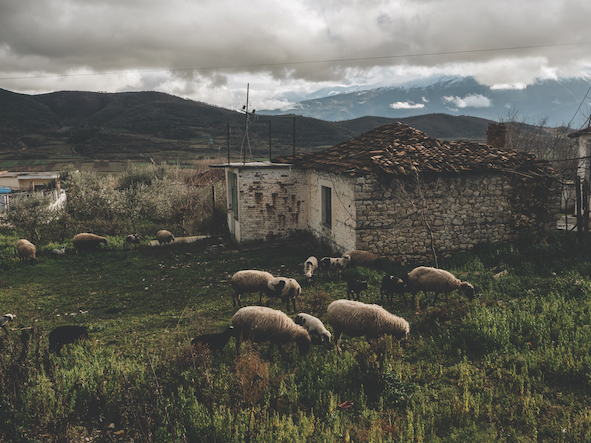The tiny southern Albanian village of Kutë, population just under 2,000 and shrinking, sits along the Vjosa River (called the Aoos River across the border in Greece), with a view of Mount Çika, one of Albania’s highest peaks, gracing the horizon. There’s a school, a couple shops, some municipal buildings. But this is rural. Pull it up on Google Maps and you’ll find images of some impressive looking sheep and a riverbank.
Like most villages in this part of Albania, homes have electricity, but people in this ageing community used torches to navigate streets after sunset. Until recently. Now, when the sun goes down, the streetlights switch on.
“All of our streets have lights now”, says 72-year-old pensioner Bujar Haxhaj. “If you come during the night here, it’s like in the city.”
Residents say they’re enjoying their newly lit streets. They’re getting together for after-sunset dinners at friends’ homes more often.
“All of our streets have lights now. If you come during the night here, it’s like in the city”
Kutë is the site of Albania’s first citizen energy community. In 2021, several of its public buildings were fitted with large solar panels. These panels currently power not just the village’s streetlights, but also a health centre, a cultural centre, the school and an administrative building.
The next step, say villagers and the environmental groups supporting them in their effort, is to transform Kutë into a fully self-sufficient energy community.
“If we can manage to do it,” says Demir Murataj, 59, a farmer born and raised in Kutë, “then supplying every family with panels will be even better.”
 Demir Murataj, 59 and his wife at their house in Kutë | Photo: Ilir Tsouko
Demir Murataj, 59 and his wife at their house in Kutë | Photo: Ilir Tsouko
But before there was light, there was water. Kutë, an agricultural community, co-exists with the Vjosa River it sits alongside, which environmental organisations routinely describe as one of the last wild rivers in Europe. Ancient references to the waterway and surrounding valley abound, with more than a few dramatic battles taking place on or near the river’s banks.
Today, the village’s farmers, like most living here in the Vjosa Valley, rely on the ecosystem – of which the river is an integral part – to maintain their crops and animals, and for fishing. The region also boasts a small tourism industry for which the river serves as an attractive site for water sports and destination fishing.
As Murataj poignantly puts it: “The Vjosa River and I have grown up together. We have it as part of our lives, it is the wildest river.”
This co-existence, and the continuation of Kutë altogether, came under threat in the 2010s when plans were unveiled to construct a hydropower dam on the river.
Villagers and environmentalists say that the Poçem hydropower plant, which was part of a larger plan to build 400 hydropower plants across the country, would have flooded Kutë’s agricultural fields, destroyed its ecosystem and, ultimately, made the village uninhabitable.
According to a paper published by the International Renewable Energy Agency (IRENA) in 2021, Albania has one of the highest shares of renewable energy in south-east Europe. Hydropower accounts for the largest share of the country’s electricity generation: about 95 per cent of Albania's installed power capacity.
Resistance to the Poçem dam was not limited to the residents of Kutë, but theirs was the loudest. It made local and international headlines when a group of 38 Kutë citizens, along with environmental groups EcoAlbania, RiverWatch and EuroNatur went to court in an effort to stop construction of the dam. The headlines grew louder when their lawsuit effectively achieved success in 2017.
Here’s where the idea for a solar energy community comes in. As part of their efforts to resist construction of the hydropower dam, Kutë’s residents and the environmental groups working with them sought to convince the big shots that less destructive energy generation alternatives were a truly viable option – not just for the area that would have been served by the Poçem dam, but across Albania as a whole.
“One of the alternatives that we think is completely unused in Albania is solar energy. And the message we wanted to give is that this community really doesn’t need the Poçem hydropower plant because there are other options to get energy,” says Besjana Guri, an environmental expert from EcoAlbania, who has worked closely with the community.
 Bujar Haxhaj, 72, in Kutë | Photo: Ilir Tsouko
Bujar Haxhaj, 72, in Kutë | Photo: Ilir Tsouko
“Of course, at the same time, it would also help the community for the local government to reduce the energy bill, and in the same way to produce energy through solar panels on their roofs,” she continues.
One crowdfunding campaign later, led by EcoAlbania with support from Kutë’s residents and a wide range of backers that even included the American outdoor clothing company Patagonia, enough funds were raised to bring the first phase of solar panels to Kutë.
In December 2021, the lights switched on, and Albania’s first citizen energy community was born.
“The Vjosa River and I have grown up together. We have it as part of our lives, it is the wildest river”
Kutë’s energy project might be an exception in Albania, but it is part of a larger trend across Europe and the continent’s growing citizen energy movement.
“Citizen energy communities”, “energy cooperatives” and “energy collectives” are all terms describing essentially the same thing: a localised energy generation model rooted in the idea that citizens can be active participants in the production of renewable energy in their communities. That citizens can, quite literally, take energy production into their own hands.
Energy communities aim to pave the way for the transition to energy democracy. This environmental justice concept rests upon the idea that the production, management and distribution of energy should be democratised through principles such as social ownership of energy infrastructure, active public participation in energy-related policymaking and the decentralisation of energy production.
The distribution of energy communities across Europe is anything but equal. With the notable exception of Crete’s Minoan Energy, the biggest energy community in Greece, which was recently awarded the European Sustainable Energy Award by the European Commission, finding examples of citizen energy communities in south-east Europe is a challenge.
According to EcoAlbania’s Guri, initiatives like that in Kutë have very positive outcomes. Producing energy that benefits the whole community, she argues, promotes a sense of unity. However, there is one main obstacle that prevents the citizens of Kutë from reaching the project’s full potential: the law.
As of now, Albanian law does not include provisions for establishing energy communities in the EU’s sense of the term. In 2019, the bloc adopted the Clean energy for all Europeans package, a key part of which was the Directive on common rules for the internal electricity market. The latter lays down rules to enable active consumer participation in all markets, including through citizen energy communities. This can look like generating, consuming, sharing or – crucially – selling electricity.
 Kutë didn't have working streetlights for decades. Now solar panels provide energy to light the village's streets at night | Photo: Ilir Tsouko
Kutë didn't have working streetlights for decades. Now solar panels provide energy to light the village's streets at night | Photo: Ilir Tsouko
Even EU Member States are struggling to keep up with the fast-evolving reality of energy communities in their national legislation. Some have been slow in transposing the directive while others have erected obstacles that complicate the creation of these collectives.
Currently, the law in Albania “does not allow you as a community to turn overproduced energy into monetary value”, explains Guri. Although environmentalists and villagers alike hope future legislation might change this.
Lights or no lights, Kutë is not without its problems. The population is ageing, and young people aren’t sticking around.
Some residents hope next steps will include not just the creation of a fully self-sustaining energy community for the village, but an infrastructure powerful enough to generate excess electricity that could be sold for profit.
Says Haxhaj, the Kutë resident, “This new project can save us a little money in family energy, but only that much. A bigger organisation is needed, perhaps including the state.”
Sign up to The Parliament's weekly newsletter
Every Friday our editorial team goes behind the headlines to offer insight and analysis on the key stories driving the EU agenda. Subscribe for free here.